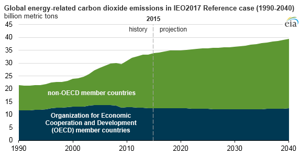EIA: Growth in global energy-related CO<sub>2</sub> emissions expected to slow
EIA projects that growth in global carbon dioxide (CO2) emissions from energy-related sources will slow despite increasing energy consumption. EIA’s International Energy Outlook 2017 (IEO2017) Reference case projects that energy-related CO2 emissions will grow 0.6% per year from 2015 to 2040, a slower rate of growth than the 1.8%/yr experienced from 1990 to 2015. Emissions from countries outside the Organization for Economic Cooperation and Development (OECD) account for all of EIA’s projected growth in energy-related CO2 emissions.
Energy-related CO2 emissions from non-OECD countries exceeded those from the OECD countries in 2005. The IEO2017 Reference case projects that energy-related CO2 emissions from non-OECD countries will grow 0.9% per year from 2015–2040, which is much lower than the 3.2% per year average growth rate from 1990 to 2015.
EIA expects non-OECD countries to experience a 1.4%/yr rate of increase in annual energy consumption from 2015 through 2040. The overall population in non-OECD countries is projected to grow more than twice as fast as that of OECD member countries, and the demand growth for energy services such as air conditioning, home electronics, and personal vehicles increases with rising incomes.
Some of the CO2 emissions related to increasing non-OECD energy demand are likely to be mitigated by changes in the fuel mix, similar to trends seen in the OECD countries. In 2015, renewable energy and nuclear power accounted for 14% of non-OECD countries’ energy consumption. By 2040, the IEO2017 projects that percentage to increase to 21%. EIA expects coal demand and related CO2 emissions, especially in China, to flatten as natural gas replaces coal in power generation and in industrial applications. China is currently the largest emitter of energy-related CO2 emissions in the world and is projected to remain in that position through 2040.
Energy-related CO2 emissions from OECD countries are projected to be flat from 2015 to 2040 in the IEO2017 Reference case, slightly lower than the annual rate of growth from 1990 to 2015 when OECD CO2 emissions increased 0.3%/yr. In OECD countries, energy consumption grows by 0.3%/yr in the IEO2017 Reference case. However, enough low- and non-carbon fuel sources are added to the energy mix that EIA does not project the amount of CO2 released annually in these countries to increase by 2040. The IEO2017 Reference case forecasts renewable and nuclear energy in OECD countries to rise from 21% of OECD countries’ energy consumption in 2015 to 25% in 2040, with the United States expected to remain the largest emitter of energy-related CO2 emissions among OECD countries through 2040.
Because OECD economies are relatively mature, markets for many energy services such as air conditioning and personal transportation are saturated. Population growth is relatively low, and technology improvements largely mitigate population growth-related increases in energy demand in buildings and vehicles.
in addition, economic activity continues to become less energy intensive as these economies shift from energy-intensive manufacturing to less energy-intensive manufacturing and services. In terms of energy and carbon intensities, non-OECD countries are expected to become less energy intensive than OECD countries by 2027, meaning they use less energy to generate economic activity. However, non-OECD countries are expected to remain more carbon intensive than OECD countries, meaning they generate more CO2 emissions per unit of energy consumed.







Comments